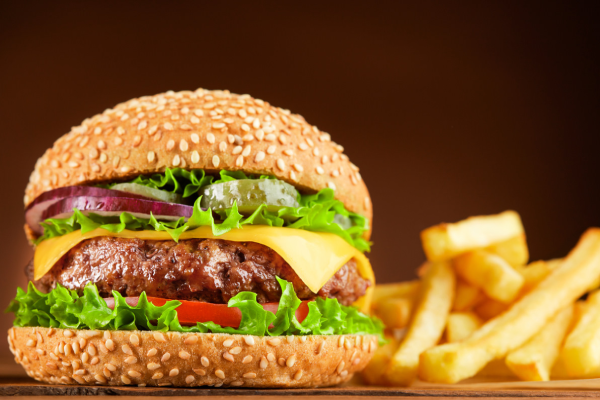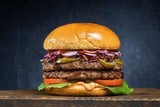What Makes a Great Beef Burger
A great beef burger is more than just a quick meal—it’s an experience, a perfect combination of flavors and textures that bring satisfaction in every bite. Crafting the perfect beef burger requires attention to detail, from the choice of beef to the selection of condiments. It’s a balance of high-quality ingredients, cooking techniques, and thoughtful assembly. Here are the key elements that contribute to making a beef burger exceptional:
1. High-Quality Beef with the Right Fat Content
The foundation of a great beef burger begins with the beef itself. The quality of the meat will determine the burger’s flavor and juiciness. A burger made with premium, freshly ground beef will always stand out from the rest. The ideal beef for burgers is usually ground beef with an 80/20 lean-to-fat ratio, which means 80% lean meat and 20% fat. This ratio is crucial for achieving a juicy, flavorful patty. Too much fat can make the burger greasy, while too little fat will result in a dry, bland patty.
Popular cuts for burgers include ground chuck, which offers a good balance of flavor and fat. Some chefs also blend different cuts, such as brisket and short rib, for added richness and depth of flavor. The freshness of the beef also plays a critical role in the overall quality of the burger. Pre-packaged ground beef can often be less flavorful and less fresh, so it’s always best to grind your own beef when possible, or to get it freshly ground at a butcher.
In addition to the fat content, the way the beef is handled before and after grinding is essential. Freshly ground beef tends to have a much more vibrant flavor, and it maintains its juiciness better than older meat. Moreover, ensure the beef is not overworked when forming the patties. Overworking the meat will make it tough and chewy. The goal is to maintain the tenderness and natural juiciness that makes beef so delicious.
2. Perfect Patty Formation and Cooking
The way the patty is formed and cooked is just as important as the beef itself. A good burger patty should be tender, juicy, and have a satisfying texture. Start by gently shaping the patties. It’s tempting to press down on the meat with force to create uniform patties, but doing so will compact the meat and result in a tough texture. Instead, gently shape the patties, keeping them a bit loose, so they stay tender as they cook.
Cooking the burger is where the magic happens. To achieve the perfect burger, you need to cook it over high heat. This allows the Maillard reaction to occur, which is the process that creates that beautiful, caramelized crust on the outside of the patty while keeping the inside moist and flavorful. Cooking over high heat also ensures the juices are locked in, so the burger doesn’t dry out during cooking.
The ideal doneness for a burger is usually medium-rare to medium. This means a core temperature of around 130-140°F (54-60°C). At this level, the patty remains juicy and flavorful without being undercooked. However, food safety should always be a priority, and ground beef should be cooked to an internal temperature of 160°F (71°C) to ensure it is fully cooked. The choice of doneness also depends on personal preference. Some people prefer a burger with a little more char, while others prefer a more tender and juicy result.
If you're making a smash burger, which has become increasingly popular in recent years, the technique differs slightly. Smash burgers are made by pressing the patty onto a hot griddle or skillet, which creates a thinner patty with a significant amount of surface area. This technique maximizes the crust and flavor, resulting in a burger that’s crispy on the outside and juicy on the inside.
3. Balanced Bun-to-Patty Ratio and Toasted Buns
The bun plays an essential role in the burger experience, but it should never overshadow the patty itself. A great burger has a balanced bun-to-patty ratio, meaning that the bun should be sturdy enough to hold the burger without overpowering it. The size of the bun should complement the size of the patty. If the bun is too large, it can overwhelm the burger and lead to a disjointed eating experience. Conversely, if the bun is too small, it won’t hold up to the juicy patty, which can result in a soggy mess.
Brioche buns are a popular choice for their slight sweetness and soft texture, which pair well with the savory beef patty. Pretzel buns, with their firm yet chewy texture, can add a pleasant contrast to the softness of the patty. They also tend to hold up well to the juiciness of the meat and any toppings.
No matter the type of bun, it’s important to toast it before assembling the burger. Toasting the bun helps create a slight crunch and prevents it from absorbing too much moisture from the patty and condiments. It also adds flavor and texture, elevating the entire burger.
4. Fresh, Quality Toppings
Toppings are where you can get creative and experiment with different flavors and textures. Fresh vegetables, like crisp lettuce, ripe tomatoes, and thinly sliced onions, are classic choices for a reason. They provide a refreshing contrast to the richness of the beef and add a satisfying crunch. The quality of the vegetables is key here—fresh, in-season produce will make a noticeable difference in taste.
However, you can also go beyond the basics with gourmet toppings. Caramelized onions, sautéed mushrooms, and crispy bacon can bring new layers of flavor to the burger, creating a more complex and satisfying taste profile. Specialty cheeses like sharp cheddar, creamy brie, or spicy pepper jack can also take the burger to the next level, adding richness or a kick of flavor.
The key with toppings is balance. You don’t want the toppings to overwhelm the beef patty. Focus on quality over quantity and choose toppings that complement, rather than compete with, the burger’s flavor.
5. Complementary Condiments and Sauces
Condiments are a burger’s secret weapon. They’re what ties everything together and adds a burst of flavor. Ketchup, mustard, and mayonnaise are traditional condiments that are classic for a reason. Ketchup provides a touch of sweetness, mustard adds tang, and mayonnaise gives creaminess.
However, many burger enthusiasts are turning to more creative and flavorful sauces to elevate their burgers. Signature or house-made sauces like garlic aioli, chipotle mayo, or barbecue sauce can add a unique flair to the burger, allowing for personalized flavor combinations. The goal with sauces is to complement the beef, not mask its natural taste. Don’t overdo it—just a little drizzle of sauce will do the trick to enhance the burger’s overall flavor.
Summary
A great beef burger is the perfect combination of quality beef, thoughtful preparation, and the right balance of ingredients. It all starts with high-quality beef with the right fat content, freshly ground and carefully cooked to preserve its juiciness and flavor. The bun should complement the patty and be toasted to perfection, while fresh, quality toppings add layers of texture and flavor. Finally, the condiments tie everything together, ensuring that the burger is a balanced and satisfying experience in every bite.
Creating the perfect beef burger takes time and attention to detail, but the result is a delicious, unforgettable meal. Whether you're grilling at home or enjoying a burger at a restaurant, remember that a truly great burger comes from using the best ingredients, cooking with care, and balancing flavors in harmony.


